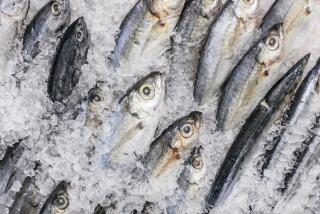U.S. Pacific Trawler Fleet Is Making Waves
- Share via
SEATTLE — Ten years ago, the United States had virtually no factory trawler fleet that could harvest the riches of the open seas, and foreign fishing vessels dominated the scene.
With the help of federal legislation and a lot of capital investment, however, that is no longer true, according to a report released by the Alaska Factory Trawler Assn.
The report, based on figures compiled by the Coopers & Lybrand accounting firm, says that the fleet that sails the North Pacific is one of the largest in the world and that it makes a significant contribution to the economies of Washington and Alaska.
Officials representing the fleet hope that, aside from trumpeting the fleet’s achievements, the report will throw some water on a political fire raging over the question of who owns the fish in the waters off Alaska.
According to the study, the fleet has grown rapidly since 1986, going from 12 trawlers worth an estimated $77 million to 43 worth $520 million in 1988, and to 57 worth $1.1 billion in 1990.
“This has become the biggest fleet in the nation,” said Bruce Buls, a spokesman for the association, which is based in Seattle. “The North Pacific is the breadbasket of U.S. fisheries. There are other areas that are working, but many are on hard times. Nothing compares with the North Pacific.”
The fleet grew with the help of the Magnuson Fishery Conservation and Management Act of 1976, the report says. The act extended U.S. fisheries’ jurisdiction to 200 miles off the coasts of the United States, including those of Alaska and Hawaii. The law gradually excluded foreign vessels from the 200-mile zone, and today, the only foreign vessels allowed in are those in joint ventures with American companies.
U.S. commercial fisheries were slow to take full advantage of the opportunities presented by the Magnuson act, however, partly because the Americans traditionally operated as independents in small boats pursuing high-value seafood such as salmon and crab. When the Pacific salmon and crab industries encountered some difficulties in the early ‘80s, however, many fishermen converted their vessels into trawlers and engaged in year-round fishing in the Bering Sea and North Pacific.
Millions of dollars were invested in new ships and processing plants and to convert existing vessels. By the late ‘80s, the fleet had become profitable.
According to the report, the trawler fleet now accounts for about 9,700 jobs in Alaska, both in the industry and because of it. The number for Washington is 8,900.
Coopers & Lybrand says the fleet contributes about $500 million a year to the economy of Washington and 56% of the $887 million that all commercial fishing brings the state. It is estimated that the factory trawlers will contribute $301 million this year to king county, where much of the fleet is based.
More to Read
Sign up for Essential California
The most important California stories and recommendations in your inbox every morning.
You may occasionally receive promotional content from the Los Angeles Times.













